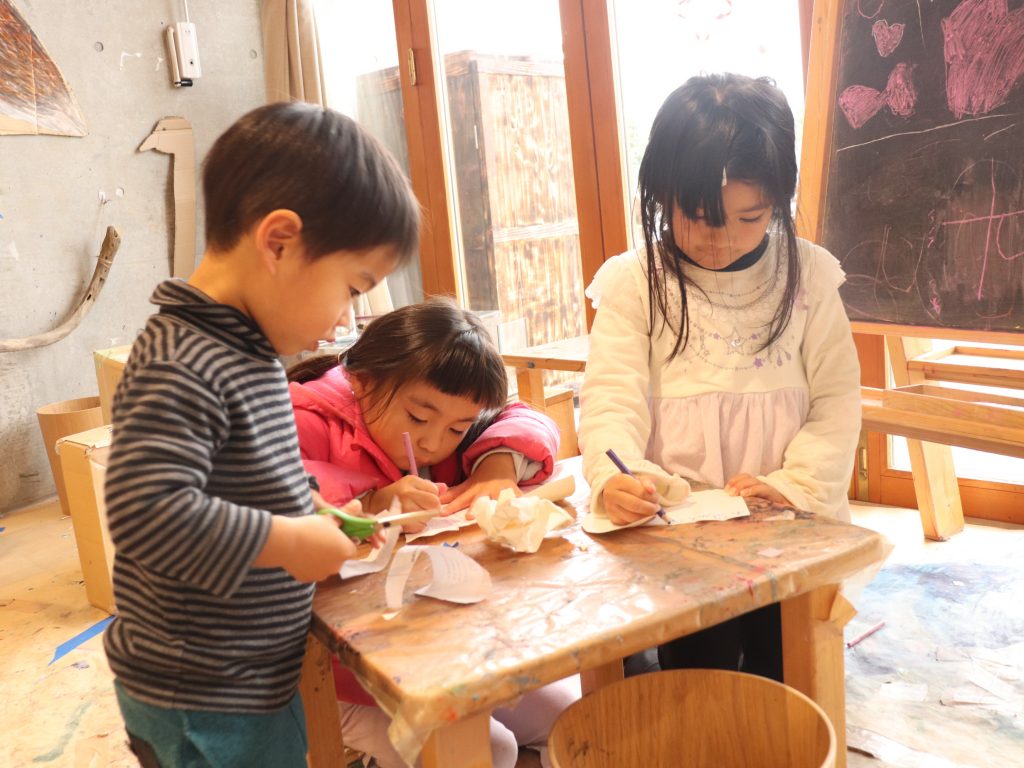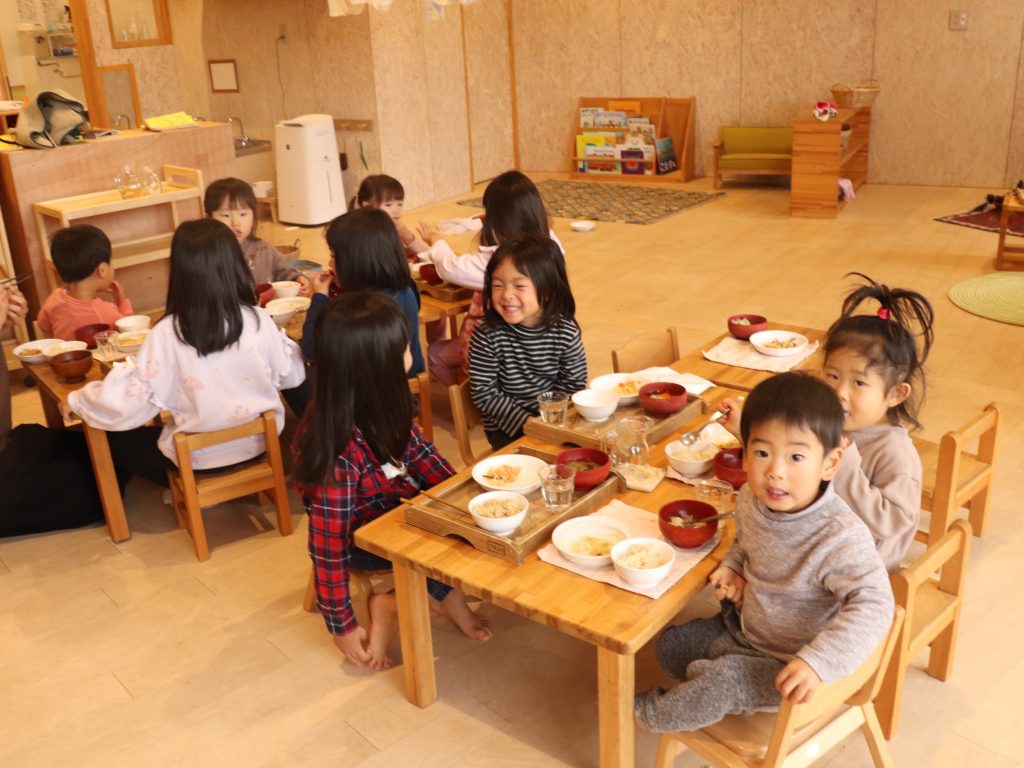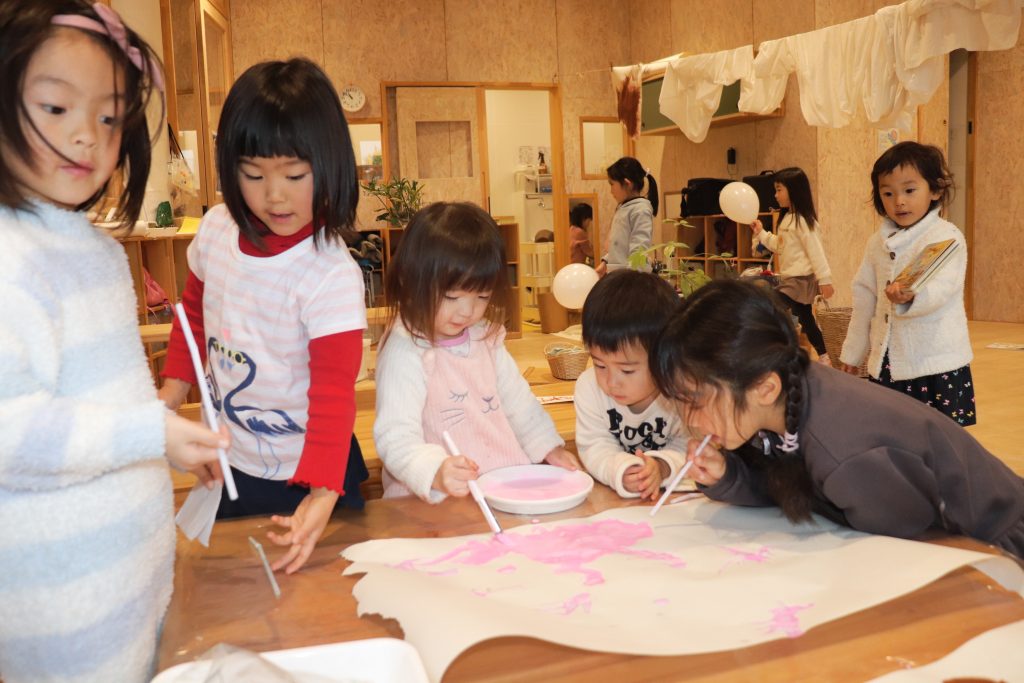
2021.09.01 Kogomi and Akebi Blend Together
Text : Ayane Fukumori
Every day, children look up to the big kids.
There is a culture of “transitioning” from Kogomi to Akebi, and for the children of Kogomi who have witnessed this, the words “going to Akebi” are very appealing and at the same time a big step that makes them a little nervous.
Currently, we are in the process of breaking down the barriers between classes and changing the group structure to make it more comfortable for the children.
However, this is only talked of among the adults.
I would like to introduce some of the chemical reactions that have occurred as the children of Kogomi and Akebi have been spending more time together.
*”Kogomi” is the name of the class where 1-2 year olds belong to and “Akebi” is that of the class for 3-5 year olds . Each class room is located in the same building, so children can spend time in either room.
Related articles:
Blended Possibilities (2020.7)
The Changes Brought by “Fusions” of Child Educators (2020.7)
[A’s Episode]
The children who have siblings are especially attracted to Akebi. A is one of them.
Around; August, she started eating lunch with B, her older brother, in Akebi’s room, which led her to say, “I will go to Akebi and play with B. Since her good friends C and D are also Kogomi-Akebi siblings, there were times when the four of them often played together.
One day, only B was absent due to illness. As soon as A arrived at Yamanoko, she told me, “B is at home with Mommy”. She continued, “I’m going to play at Akebi!” I was very surprised by this comment, because I thought that Akebi was a place where B was, and that A was going there because she wanted to play with B.
Indeed, that was the case before. However, as she spent more and more enjoyable time with B, I realized that Akebi itself had become one of the places she could choose to go and play.
That day, A came back to the Kogomi room with a sparkling face and said, “That was fun! I had a great time!” She seemed to be enjoying the “coming and going” that is unique to this time of year, going on adventures in new fields and coming back to Kogomi as a safe base.
[E’s episode]
The increase in coming and going between Kogomi and Akebi has had many effects on the younger children (one year olds) in Kogomi.
The dinosaur play is slowly gaining popularity at Kogomi. The dinosaur figures are in Akebi’s room, so the children of Kogomi also play in that corner, especially in the evening. However, the figures are also popular toys among Akebi’s children. One day, I saw E wandering around where F(three year olds) was playing with the dinosaurs. Chihiro noticed him and asked, “What’s wrong?” He said, “I also want to play with the brachiosaurus.” Some Akebi girls heard his voice and said, “Do you want to play with it, E? This way!” But F, who was absorbed in playing, kicked them out with a loud “No!”. E was so surprised by the power of the voice that he sank into a chair. He seemed to have given up on the brachiosaurus at one point, but after a while, Chihiro said, “F is so kind that he’ll let you touch it, do you want to ask him again?” F, who had heard the word “kind” nearby, held out the figure and said, “You can use it just for a moment.” Still, perhaps what he had just said had made a strong impression on E, or perhaps he was trying to be faithful to the word “just for a moment”, he simply stroked the dinosaur with his index finger and said, “That’s enough”.
Nervousness, hesitance, and help from others are reactions that are rarely seen in interactions between children of similar ages, and I felt that they were building new relationships.
[Lunchtime Episode]
Recently, some members from Kogomi eat lunch in Akebi’s room every day, and the scene of Kogomi and Akebi eating together has become quite familiar. It seems that the children of Kogomi choose to eat at Kogomi or Akebi that day according to their own mood.
One day, G, H, I, J, and K of Akebi class came to us and asked, “Can we eat at Kogomi today?” Until now, children from Kogomi have gone to Akebi to eat, but never the other way around. But there were seats available, and there was no reason to refuse. When I told them it was okay, they said, “Yes!” and they happily brought in their respective lunches. “I want to be next to you, L(Kogomi)!” “Hey, the chair is so small!” The atmosphere quickly became lively. The Kogomi children, who had been watching what was going on, smiled when they realized that their big sisters would be eating with them. Although we couldn’t sit in a large group, we were able to spend time together in a relaxed atmosphere where we could see each other clearly.
[Yamanoko Continues to Change]
What is the purpose of a class framework?
I think it is adopted in many preschools across the country because of its merits, such as to allow adults to closely monitor children’s condition and status in group life, and to facilitate the provision of age-appropriate environments and games.
And because of the differences between the classes (age groups), a sense of longing can develop, and this feeling can motivate the children to say, “I want to do something like that too.”
However, the disadvantage is that the children’s desire to play in the other class may not be fulfilled within the framework of the adult’s decision: “You’re in this class and you’re in that class”. The current Yamanoko is weighing both sides of the issue and searching for a better way.
I feel that Yamanoko is a place that is constantly changing. Whenever there is a change, the children always respond. We would like to be a place where we can catch the signs and be flexible enough to change for the betterment of the children.

















 PREV
PREV